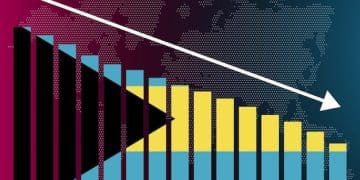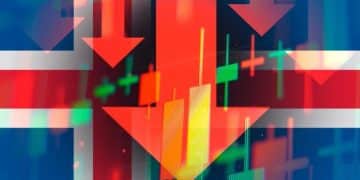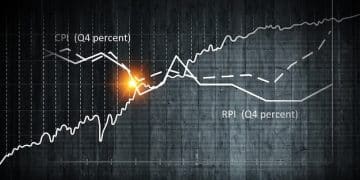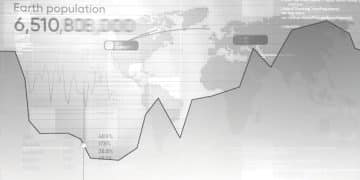Fed Rate Hike Early 2025? Expert Analysis & Predictions

Experts are closely watching economic indicators to determine if the Federal Reserve will raise interest rates again in early 2025, with inflation trends, labor market strength, and global economic stability being key influencing factors shaping predictions from leading financial analysts.
As we approach the critical juncture of early 2025, a pervasive question lingers in financial circles: Will the Fed Raise Interest Rates Again in Early 2025? Expert Analysis and Predictions delve into the complex interplay of economic data, policy nuances, and market sentiment that will ultimately shape the Federal Reserve’s decisions. Understanding these dynamics is crucial for investors, businesses, and consumers alike.
Understanding the Federal Reserve’s Mandate and Tools
The Federal Reserve, often referred to as “the Fed,” operates with a dual mandate from Congress: to achieve maximum employment and maintain price stability. These two objectives frequently pull in different directions, making monetary policy decisions a delicate balancing act. When inflation rises, the Fed typically considers raising interest rates to cool down the economy and bring prices under control. Conversely, during periods of economic slowdown or high unemployment, it might lower rates to stimulate growth.
The primary tool the Fed uses to influence the economy is the federal funds rate, which is the target rate for overnight lending between banks. While the Fed doesn’t directly set consumer interest rates, changes to the federal funds rate ripple through the financial system, affecting everything from mortgage rates and auto loans to credit card interest and business borrowing costs. The forward guidance provided by Fed officials also plays a significant role, signaling potential future policy moves and influencing market expectations.
Key Economic Indicators Guiding Fed Decisions
Several critical economic indicators are constantly under the Fed’s microscope. These data points provide a comprehensive picture of the economy’s health and help policymakers determine the appropriate course of action.
- Inflation Data: The Consumer Price Index (CPI) and the Personal Consumption Expenditures (PCE) price index are paramount. The Fed often targets a 2% PCE inflation rate, and significant deviations from this target strongly influence rate decisions.
- Labor Market Reports: The monthly jobs report, including non-farm payrolls, unemployment rate, and wage growth, is crucial. A strong labor market with rising wages can indicate inflationary pressures, while weakness may suggest a need for accommodative policy.
- GDP Growth: Gross Domestic Product (GDP) measures the economy’s overall output. Sustained strong growth might prompt the Fed to consider tightening monetary policy to prevent overheating.
- Consumer Spending and Business Investment: These gauges of economic activity provide insights into demand and future growth prospects. Robust spending can fuel inflation, while sluggish investment can signal an impending slowdown.
The Fed’s decisions are not made in a vacuum; they are the result of extensive analysis, deliberations, and projections by members of the Federal Open Market Committee (FOMC). Their statements and meeting minutes offer valuable clues to their collective thinking and future intentions, making them essential reading for anyone trying to predict the next rate move.
Current Economic Landscape and Inflationary Pressures
The global economy has experienced unprecedented shifts in recent years, largely driven by the aftermath of the pandemic, supply chain disruptions, and geopolitical events. These factors have created a complex environment for central banks worldwide, including the Federal Reserve. The debate about whether current inflation is primarily “demand-driven” or “supply-side” continues to shape policy responses, as each diagnosis implies a different set of effective interventions.
Consumer price indices have shown volatility, with some sectors experiencing persistent price hikes while others moderate. Energy prices, housing costs, and food inflation remain significant concerns for many households, directly affecting their purchasing power and economic outlook. The Fed’s primary objective is to anchor inflation expectations, preventing a self-fulfilling prophecy where consumers and businesses anticipate higher prices and adjust their behavior accordingly. If inflation becomes entrenched, the costs of bringing it back down can be substantial, often involving sharper rate hikes and a greater risk of economic contraction.
Supply Chain Dynamics and Global Influences
While domestic demand plays a role, global supply chain issues have undeniably contributed to inflationary pressures. Disruptions caused by factors such as geopolitical tensions, climate events, and lingering effects of the pandemic have constrained the flow of goods and raw materials, driving up costs for producers and, consequently, prices for consumers. The Fed must consider how these external factors, which are largely beyond its control, might influence the sustainability of inflation.
Moreover, the strength of the U.S. dollar, influenced by interest rate differentials and global economic stability, also impacts inflation. A stronger dollar can make imports cheaper, potentially easing inflationary pressures, while a weaker dollar can have the opposite effect. The Fed’s policy choices are therefore intertwined with global economic developments and the policies of other major central banks.
Forecasting inflation is not an exact science. Many variables are at play, and unexpected events can quickly alter the trajectory. The Fed continuously updates its economic projections, taking into account the latest data and emerging trends to form its outlook on price stability and the appropriate monetary policy response. This ongoing assessment is crucial for understanding whether further rate adjustments will be deemed necessary in early 2025.
Labor Market Health and Wage Growth
A resilient labor market has been a hallmark of the post-pandemic economic recovery, often exceeding expectations. The Federal Reserve closely monitors various metrics to gauge the health of the employment landscape, as it is a critical component of its dual mandate and a significant driver of inflationary pressures. A robust job market, characterized by low unemployment and strong wage growth, can fuel consumer spending and contribute to demand-pull inflation, prompting the Fed to consider a more restrictive monetary policy stance.
Key indicators, such as the unemployment rate, labor force participation, and average hourly earnings, are scrutinized each month. While a low unemployment rate is generally positive, historically tight labor markets can lead to wage-price spirals if wage growth outpaces productivity gains. This scenario is particularly concerning for the Fed, as it can make inflation more persistent and difficult to curb. However, many economists argue that recent wage growth, while elevated, has largely been catching up after years of stagnation and has not yet significantly outstripped productivity.
Impact of Workforce Participation and Skills Gap
Beyond headline numbers, the Fed also looks at underlying trends in the labor market. Changes in labor force participation rates, especially among different demographic groups, can offer insights into the true capacity of the economy. A persistent skills gap in certain sectors can also contribute to wage pressures, as employers compete for a limited pool of qualified talent. These structural issues can make it harder for the Fed to achieve its price stability target solely through interest rate adjustments.
The pace of job creation and the number of job openings are also vital signs. A high number of job openings relative to unemployed individuals suggests strong demand for labor, often accompanied by upward wage pressure. Conversely, a noticeable cooling in job openings could indicate a weakening economy, which would make the Fed less inclined to raise rates. The central bank’s challenge is to find the right balance: maintain maximum sustainable employment without allowing an overheated labor market to generate excessive inflation.
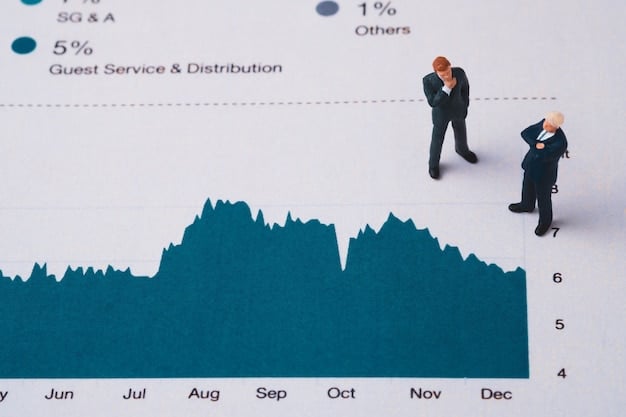
Ultimately, the trajectory of the labor market in late 2024 and early 2025 will be a pivotal factor in the Fed’s decision-making process. If employment remains strong with continued wage increases above productivity, the likelihood of a rate hike might increase. However, any signs of significant deceleration or rising unemployment would likely push the Fed towards a more dovish stance, keeping rates stable or even considering cuts.
Divergent Expert Predictions and Analyst Sentiment
The financial world is rarely unanimous, and the question of whether the Fed will raise interest rates again in early 2025 is no exception. Expert predictions are currently diverse, reflecting a range of interpretations of economic data, differing outlooks on future inflation, and varied opinions on the Fed’s reaction function. This divergence highlights the inherent uncertainty in forecasting complex economic phenomena, particularly when global factors and unforeseen events can quickly alter the landscape.
Some prominent economists and institutions foresee a scenario where persistent inflationary pressures, coupled with a resilient labor market, compel the Fed to implement at least one more rate hike. This perspective often emphasizes the “higher for longer” narrative, suggesting that bringing inflation fully back to the 2% target will require a more prolonged period of restrictive monetary policy than initially anticipated. They might point to specific components of inflation, such as services or housing, which have proven to be more Sticky than others, necessitating further action.
Arguments for Further Rate Hikes
- Persistent Core Inflation: If core inflation (excluding volatile food and energy prices) remains stubbornly above the Fed’s 2% target, it could signal underlying demand that still needs to be reined in.
- Strong Wage Growth: Continued robust wage increases, especially if they outpace productivity improvements, might be seen as contributing to a potential wage-price spiral, justifying a tighter monetary stance.
- Resilient Consumer Spending: If consumer demand remains robust despite existing rate hikes, the Fed might conclude that its policies haven’t been sufficiently restrictive to cool the economy.
Conversely, another significant camp of analysts believes that the Fed has essentially completed its hiking cycle or that any further hikes would be counterproductive, potentially tipping the economy into a recession. This viewpoint often stresses the lagged effects of monetary policy, arguing that the full impact of past rate increases has yet to be felt. They might highlight softening indicators, such as decelerating credit growth, cooling housing markets, or a moderation in job openings, as evidence that the economy is already on a path toward disinflation.
Arguments Against Further Rate Hikes
- Lagged Policy Effects: Monetary policy operates with a delay; past rate hikes are still working their way through the economy and will continue to exert downward pressure on inflation.
- Decelerating Economic Growth: Signs of weakening GDP growth or increasing unemployment would suggest that the economy is already slowing, making additional rate hikes unnecessary and risky.
- Disinflationary Trends: If inflation continues a clear downward trend towards the 2% target, especially if supply chains normalize and commodity prices stabilize, further tightening might not be warranted.
The sentiment among market participants, often reflected in bond yields and futures contracts, also provides a snapshot of current expectations. However, these sentiments can shift rapidly in response to new economic data or Fed communications. Ultimately, the Fed will base its decision on its assessment of incoming information against its dual mandate, striving to achieve a “soft landing” where inflation is controlled without triggering a severe economic downturn.
The Federal Reserve’s Forward Guidance and Market Expectations
The Federal Reserve understands the power of communication, and its “forward guidance” has become an increasingly important tool in managing market expectations. By signaling its likely future policy path, the Fed aims to reduce uncertainty, enhance the effectiveness of its monetary policy, and avoid abrupt market reactions. This guidance comes in many forms, including official statements after FOMC meetings, economic projections (the “dot plot”), and speeches by individual Fed officials.
Market participants eagerly dissect every word from the Fed, especially the nuances in language that might indicate a shift in policy outlook. For instance, subtle changes in phrasing regarding the “appropriate stance of monetary policy” or the “economic outlook” can send significant signals to investors. The Fed’s dot plot, which illustrates each FOMC member’s projection for the federal funds rate, provides a valuable glimpse into the committee’s collective thinking about the future trajectory of rates.
Interpreting the “Dot Plot”
The dot plot is a quarterly publication that shows where each FOMC participant expects the federal funds rate to be at the end of the current year, the next few years, and in the longer run. While it’s not a commitment to a specific policy path, it offers insight into the committee’s consensus and individual members’ views. If the median dot for early 2025 indicates a higher rate, it suggests a greater likelihood of further hikes, all else being equal. Conversely, a cluster of dots around the current rate or lower would signal a potential pause or even cuts.
However, market expectations don’t always align perfectly with the Fed’s guidance. Sometimes, markets are more optimistic or pessimistic about the economy’s direction or the Fed’s resolve. This “disagreement” can lead to market volatility. The Fed often tries to bridge this gap through clear communication, but it’s a constant challenge given the dynamic nature of economic data and global events.
In the run-up to early 2025, market participants will be closely watching for any changes in the Fed’s forward guidance. Any hints of “data dependency” – meaning the Fed’s decisions are highly contingent on upcoming economic reports – will prompt even greater scrutiny of inflation, employment, and growth figures. The interplay between the Fed’s deliberate signals and the market’s evolving expectations will heavily influence whether another rate hike becomes a reality.
Potential Ramifications of a Rate Hike in Early 2025
Should the Federal Reserve opt to raise interest rates again in early 2025, the ramifications would be far-reaching, affecting various sectors of the economy and financial markets. Understanding these potential impacts is crucial for individuals, businesses, and investors to prepare and adjust their strategies. A rate hike, by design, aims to cool the economy, but it does so by making borrowing more expensive, which can have both intended and unintended consequences.
Impact on Consumers and Businesses
- Higher Borrowing Costs: Mortgage rates, auto loan rates, and credit card interest rates would likely tick up, increasing the cost of borrowing for consumers. This could dampen demand for big-ticket items and reduce disposable income.
- Business Investment: Companies might find it more expensive to borrow for expansion, capital expenditures, or hiring, potentially slowing down overall business growth and job creation. Small businesses, in particular, could feel the pinch more acutely.
- Savings Returns: On the flip side, savers could see higher returns on their deposits, though these gains often lag behind increases in borrowing costs.
For the housing market, another rate hike could further cool demand, making homeownership less affordable for some prospective buyers and potentially leading to a deceleration or even a slight decline in home prices in certain regions. The stock market’s reaction would likely depend on the underlying reasons for the hike. If it’s perceived as a necessary step to curb persistent inflation, the reaction might be manageable. However, if it signals an economy struggling with high inflation and slowing growth, it could trigger a more negative response. Sectors sensitive to interest rates, such as technology and real estate, might experience greater volatility.
Global Economic Implications
A U.S. rate hike doesn’t happen in isolation. It can have significant global implications. Higher rates in the U.S. tend to strengthen the dollar, making U.S. exports more expensive and imports cheaper. This can create challenges for countries that rely on exports to the U.S. or that have dollar-denominated debt, as the cost of servicing that debt increases. Emerging markets, in particular, can be vulnerable to capital outflows if investors seek higher returns in dollar-denominated assets.
Moreover, a more restrictive Fed policy could dampen global economic growth if other central banks follow suit or if global financial conditions tighten as a result. The interconnectedness of the modern global economy means that the Fed’s decisions ripple far beyond U.S. borders, influencing trade, investment flows, and currency markets worldwide. Policymakers at the Fed are well aware of these international spillovers and factor them into their deliberations, though their primary focus remains on domestic economic conditions.
| Key Factor | Brief Description |
|---|---|
| 📊 Inflation Trends | Persistent core inflation above 2% could trigger further rate hikes. |
| 🧑💻 Labor Market Strength | Wage growth exceeding productivity might necessitate policy tightening. |
| 🌍 Global Economic Stability | Geopolitical events and supply chain health influence Fed calculus. |
| 🗣️ Fed Forward Guidance | Official statements and “dot plot” projections shape market expectations. |
Frequently Asked Questions
The Federal Reserve’s dual mandate, set by Congress, is to achieve both maximum employment and price stability. These two objectives guide all of the Fed’s monetary policy decisions, often requiring a delicate balance between stimulating economic growth and controlling inflation.
A Fed rate hike typically leads to higher borrowing costs for consumers. This means increased interest rates on mortgages, auto loans, and credit cards. While it can offer higher returns for savers, it generally makes borrowing more expensive, potentially dampening consumer spending and demand for goods.
The Federal Reserve primarily focuses on inflation data, such as the Consumer Price Index (CPI) and Personal Consumption Expenditures (PCE), and labor market reports, including the unemployment rate and wage growth. GDP growth and consumer spending are also significant indicators.
“Forward guidance” refers to communications from the Federal Reserve about the likely future path of monetary policy. This includes official statements, economic projections (the “dot plot”), and speeches by Fed officials, all aimed at managing market expectations and enhancing policy effectiveness.
Global factors, such as supply chain dynamics, geopolitical events, and the strength of the U.S. dollar, significantly influence the Fed’s decisions. These factors can impact inflation, economic growth, and financial stability both domestically and internationally, adding complexity to policy choices.
Conclusion
The question of whether the Federal Reserve will raise interest rates again in early 2025 remains a subject of intense debate among economists and market watchers. The decision will hinge on a meticulous evaluation of incoming economic data, particularly concerning inflation, the health of the labor market, and broader economic growth trends. While some experts foresee the necessity of further tightening to rein in persistent price pressures, others believe that the current policy stance is sufficiently restrictive, with lagged effects still working their way through the economy. The Fed’s forward guidance and its ability to communicate its intentions effectively will also play a critical role in shaping market expectations and, ultimately, the economic trajectory. For businesses and consumers, staying informed about these developments is paramount, as the Fed’s actions will continue to have a profound impact on borrowing costs, investment opportunities, and the overall financial landscape.

